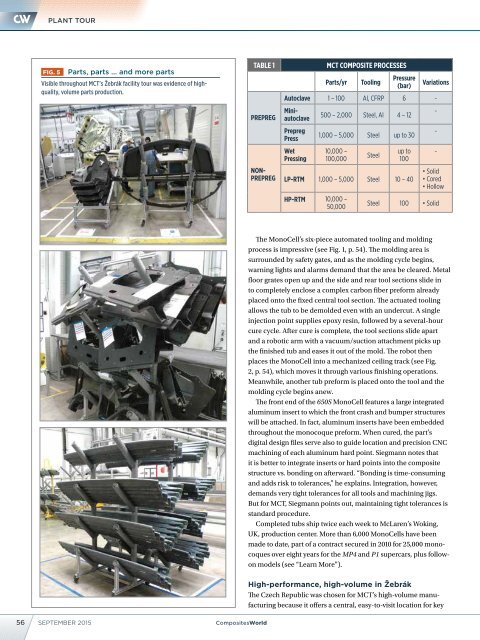FOR AUTO RTM
1VeKpGy
1VeKpGy
Create successful ePaper yourself
Turn your PDF publications into a flip-book with our unique Google optimized e-Paper software.
PLANT TOUR<br />
FIG. 5 Parts, parts ... and more parts<br />
Visible throughout MCT’s Žebrák facility tour was evidence of highquality,<br />
volume parts production.<br />
TABLE 1<br />
PREPREG<br />
MCT COMPOSITE PROCESSES<br />
Parts/yr Tooling<br />
Pressure<br />
(bar)<br />
Variations<br />
Autoclave 1 – 100 Al, CFRP 6 -<br />
Miniautoclave<br />
-<br />
500 – 2,000 Steel, Al 4 – 12<br />
NON-<br />
PREPREG<br />
Prepreg<br />
Press<br />
Wet<br />
Pressing<br />
1,000 – 5,000 Steel up to 30<br />
10,000 –<br />
100,000<br />
Steel<br />
up to<br />
100<br />
LP-<strong>RTM</strong> 1,000 – 5,000 Steel 10 – 40<br />
HP-<strong>RTM</strong> 10,000 –<br />
50,000<br />
-<br />
-<br />
• Solid<br />
• Cored<br />
• Hollow<br />
Steel 100 • Solid<br />
The MonoCell’s six-piece automated tooling and molding<br />
process is impressive (see Fig. 1, p. 54). The molding area is<br />
surrounded by safety gates, and as the molding cycle begins,<br />
warning lights and alarms demand that the area be cleared. Metal<br />
floor grates open up and the side and rear tool sections slide in<br />
to completely enclose a complex carbon fiber preform already<br />
placed onto the fixed central tool section. The actuated tooling<br />
allows the tub to be demolded even with an undercut. A single<br />
injection point supplies epoxy resin, followed by a several-hour<br />
cure cycle. After cure is complete, the tool sections slide apart<br />
and a robotic arm with a vacuum/suction attachment picks up<br />
the finished tub and eases it out of the mold. The robot then<br />
places the MonoCell into a mechanized ceiling track (see Fig.<br />
2, p. 54), which moves it through various finishing operations.<br />
Meanwhile, another tub preform is placed onto the tool and the<br />
molding cycle begins anew.<br />
The front end of the 650S MonoCell features a large integrated<br />
aluminum insert to which the front crash and bumper structures<br />
will be attached. In fact, aluminum inserts have been embedded<br />
throughout the monocoque preform. When cured, the part’s<br />
digital design files serve also to guide location and precision CNC<br />
machining of each aluminum hard point. Siegmann notes that<br />
it is better to integrate inserts or hard points into the composite<br />
structure vs. bonding on afterward. “Bonding is time-consuming<br />
and adds risk to tolerances,” he explains. Integration, however,<br />
demands very tight tolerances for all tools and machining jigs.<br />
But for MCT, Siegmann points out, maintaining tight tolerances is<br />
standard procedure.<br />
Completed tubs ship twice each week to McLaren’s Woking,<br />
UK, production center. More than 6,000 MonoCells have been<br />
made to date, part of a contract secured in 2010 for 25,000 monocoques<br />
over eight years for the MP4 and P1 supercars, plus followon<br />
models (see “Learn More”).<br />
High-performance, high-volume in Žebrák<br />
The Czech Republic was chosen for MCT’s high-volume manufacturing<br />
because it offers a central, easy-to-visit location for key<br />
56 SEPTEMBER 2015<br />
CompositesWorld


